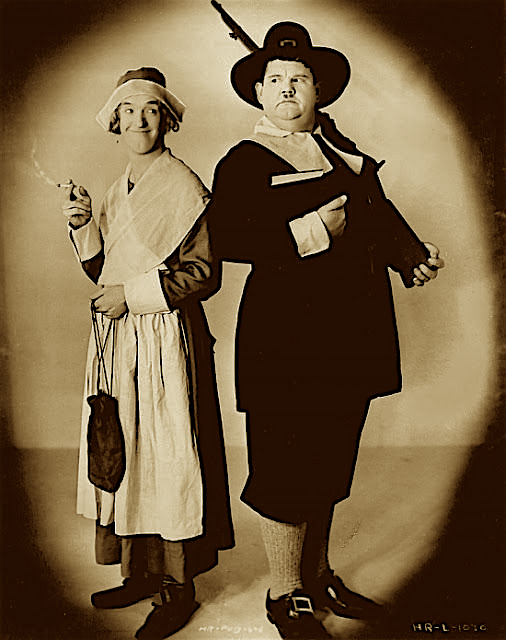MARIANI’S
Virtual
Gourmet
November
20, 2016
NEWSLETTER
❖❖❖
IN THIS ISSUE
WHAT'S NEW AND WHAT'S BETTER
THAN EVER IN NEW ORLEANS?
By John Mariani
NEW YORK CORNER
BALDANZA
By John Mariani
NOTES FROM THE WINE CELLAR
DIERBERG WINERY WANTS TO
PUT SANTA BARBARA AVA
IN THE BIG LEAGUES
By John Mariani
❖❖❖
WHAT'S NEW AND WHAT'S BETTER
THAN EVER IN NEW ORLEANS?
Part One
By John Mariani
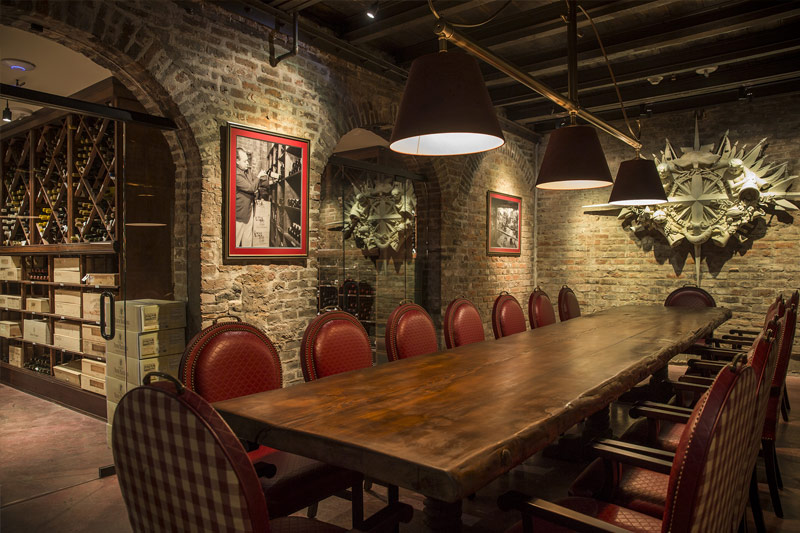
Brennan's Wine Cellar
Not from the ashes but
from the muck did New Orleans rise after
Hurricane Katrina, nowhere more evident than in
its restaurant sector, both in and out of the
French Quarter.
Older restaurants that needed serious
rehab got it and new ones had an opportunity to
shake up the city’s entrenched Creole cuisine. Here
are some of both.
BRENNAN'S
417 Royal Street
504-525-9711
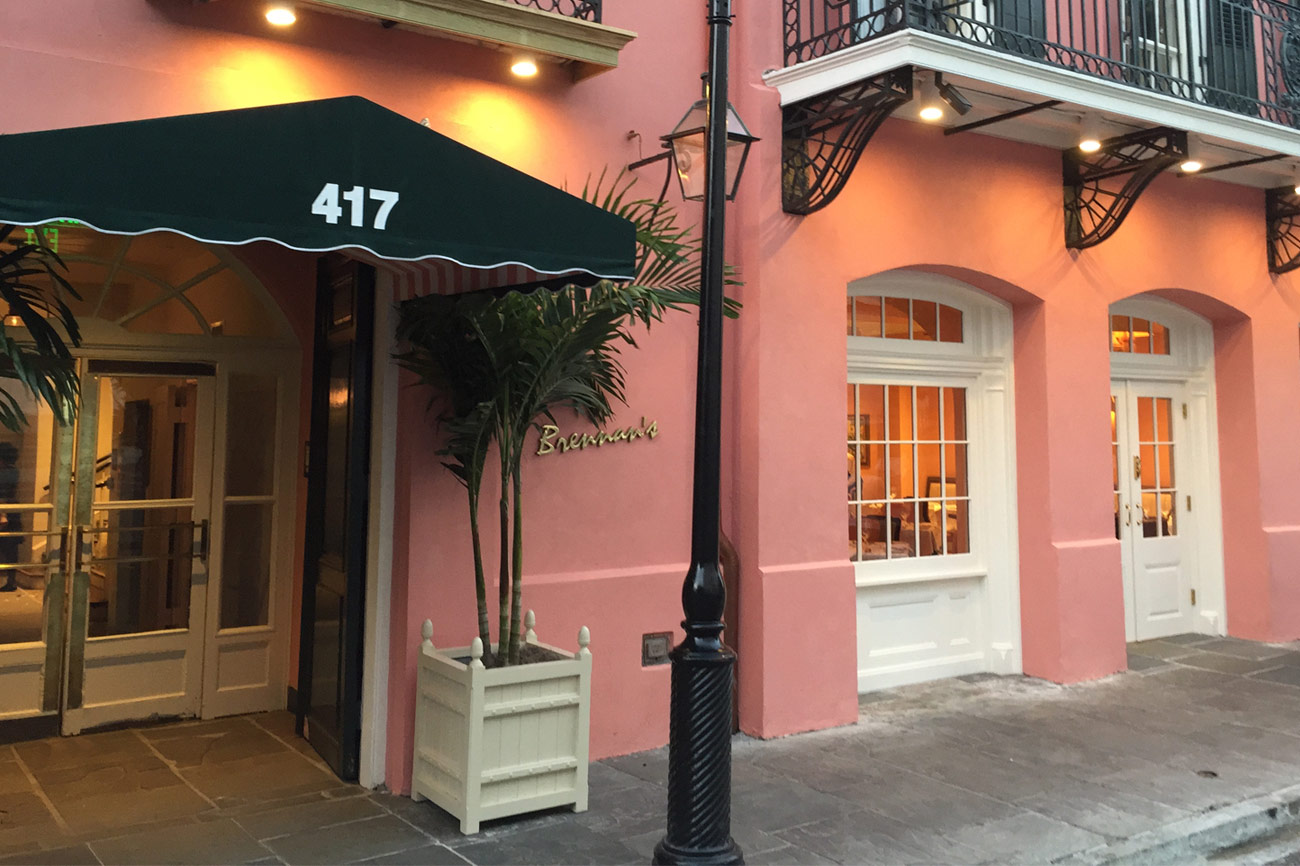 Saving
Brennan’s from both Katrina’s ravages and a
massive prior debt was a risky proposition for any
restaurateur, for as venerable as the old place
was, many thought its time had passed. But, if
anyone was going to do it, it would be Ralph
Brennan (below)
and his partner, Terry White. Brennan,
whose success as owner of Ralph’s on the Park, The
Redfish Grill, Napoleon House and several other
restaurants around the city showed he had the
clout and the will power to bring Brennan’s back
to life, not by resuscitation but by vast
improvements in every detail, from bar to private
dining rooms, from staircase to courtyard, from
kitchen to provender.
Saving
Brennan’s from both Katrina’s ravages and a
massive prior debt was a risky proposition for any
restaurateur, for as venerable as the old place
was, many thought its time had passed. But, if
anyone was going to do it, it would be Ralph
Brennan (below)
and his partner, Terry White. Brennan,
whose success as owner of Ralph’s on the Park, The
Redfish Grill, Napoleon House and several other
restaurants around the city showed he had the
clout and the will power to bring Brennan’s back
to life, not by resuscitation but by vast
improvements in every detail, from bar to private
dining rooms, from staircase to courtyard, from
kitchen to provender. 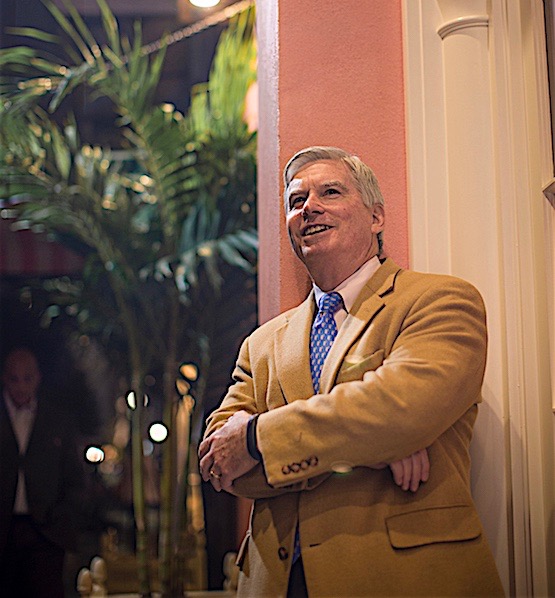
Now, with the opening of
Brennan’s Wine Cellar dining room (above), Chef
Slade Rushing will be doing tableside service and
dishes not necessarily on the daily menu in the
main dining room (below). As you
can see from the picture, the cellar is one of the
city’s most elegant new rooms. When
Katrina hit, damage was not from water (the French
Quarter is above sea level) but from a long power
outage that created mold and rot, destroying
provisions and the rarest vintages of wines. Antoine’s
lost 16,000 bottles, Emeril’s 6,000, but Brennan’s
lost 30,000 bottles, some cellared for decades in
a 1795 carriage house that is now the new cellar
and dining room, seating 16. Today, under
beverage director Joe Billesbach, the cellar
strength is back up to 1,700 labels and 13,000
bottles.
Soon after the opening of the
cellar I had a chance to dine there with assorted
other journalists to sample the kinds of dishes
Rushing is offering, all matched with wines. We
began with a Caesar salad made with duck egg,
shaved truffles and Creole-spiced croutons, all
tossed tableside and served with a Gaston Chiquet
Special Club 2007 Champagne. Showing
off both classic French and classic Louisiana
traditions, Rushing did a clear gumbo consommé
with oysters, to be enjoyed with Philippe Colin
Chassagne Montrachet 1st Cru 2008 and Deux
Montille Les Épenottes Beaune 1er Cru 2008.
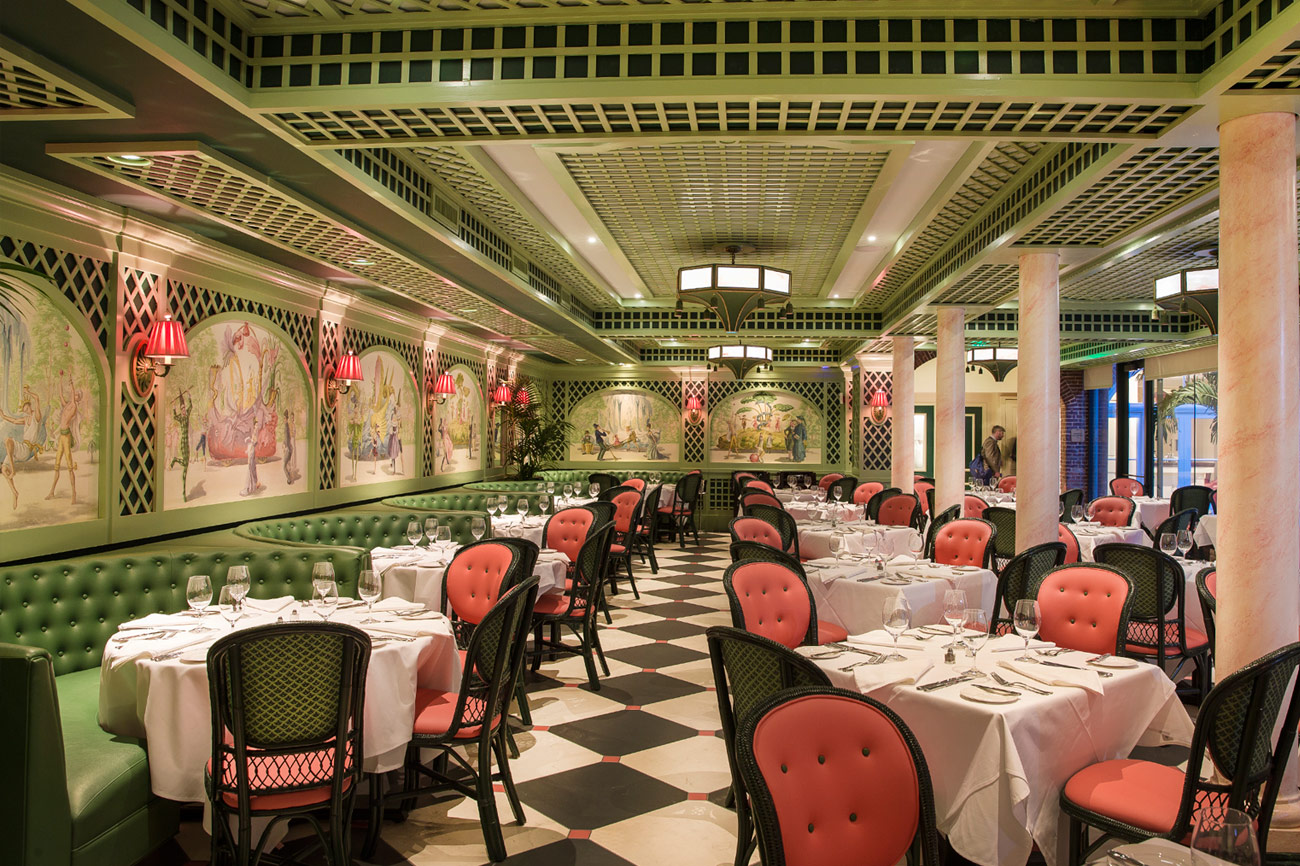 The fish course was a
carefully poached wahoo from Gulf waters in a
Mediterranean style, with Castelvetrano olives,
herbs, baby vegetable ratatouille, preserved lemon
and chicken jus, with which we enjoyed an
outstanding Italian wine, Emilio Pepe Trebbiano
d’Abruzzo 2010. Beef Wellington—a dish rarely seen
anymore and rarely made well—had the requisite
crispy pastry crust covering a layer of foie gras
and truffles,
made in individual portions and served with
baby carrots, roasted garlic and a sauce
Bordelaise; the wine was a Silver Oak Alexander
Valley Cabernet
Sauvignon 2007.
The fish course was a
carefully poached wahoo from Gulf waters in a
Mediterranean style, with Castelvetrano olives,
herbs, baby vegetable ratatouille, preserved lemon
and chicken jus, with which we enjoyed an
outstanding Italian wine, Emilio Pepe Trebbiano
d’Abruzzo 2010. Beef Wellington—a dish rarely seen
anymore and rarely made well—had the requisite
crispy pastry crust covering a layer of foie gras
and truffles,
made in individual portions and served with
baby carrots, roasted garlic and a sauce
Bordelaise; the wine was a Silver Oak Alexander
Valley Cabernet
Sauvignon 2007.
Baked Alaska is not nearly as
rare in New Orleans as elsewhere, and, although
it’s a rather childish display, its flaming
meringue peaks are always fun and it went well
with a glass of Taylor Fladgate Port 1977.
So, in the end, Brennan’s was
not only saved from destruction but imbued with a
vitality it had not had in years, and all credit
to Ralph Brennan and his crew for championing good
taste, respect for tradition and all the best
hallmarks of New Orleans hospitality.
Open daily for breakfast, lunch and
dinner.
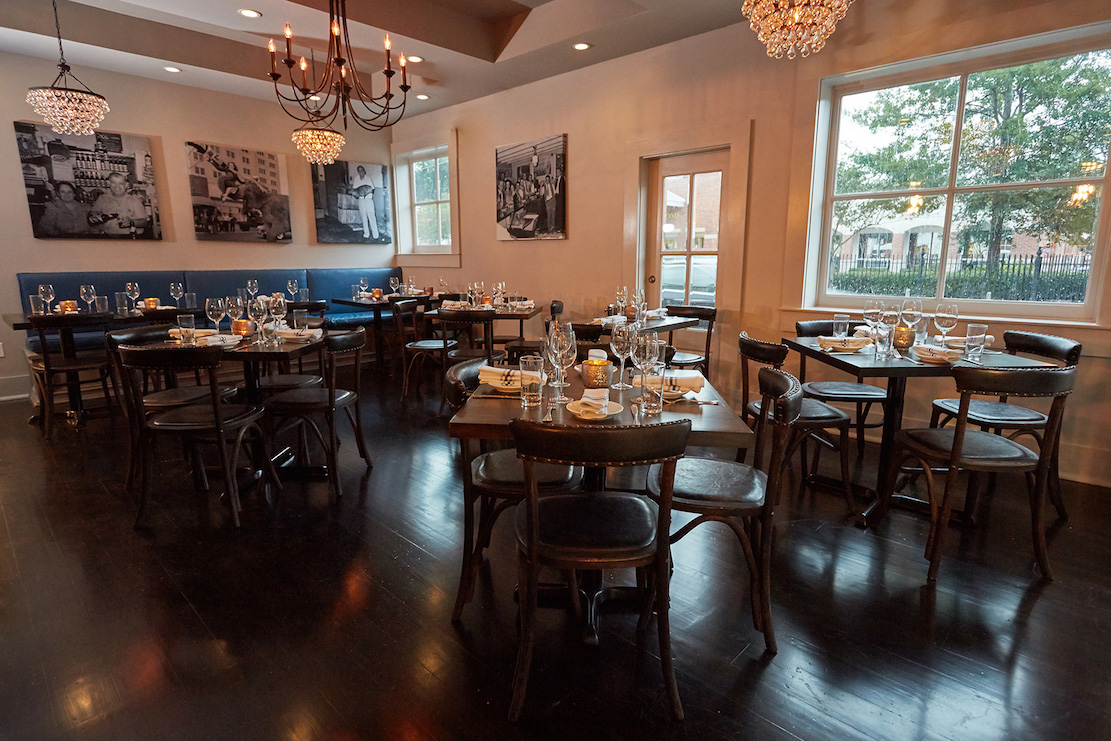
5908 Magazine
Street
504-509-6550
This charming Uptown
newcomer adds to the growing number of modern
Italian restaurants in a town that used to have
almost none even five years ago. Owner-chef
Nick Lama is a local boy with roots in Sicily, and
Avo means “forefather,” so Lama has acquired all
the cooking secrets from his mother and
grandmother’s kitchen as well as an understanding
of seafood from his father and grandfather, who
ran St. Roch Market. This is honest
cooking, generous in spirit and portion, culling
the best from Gulf waters.
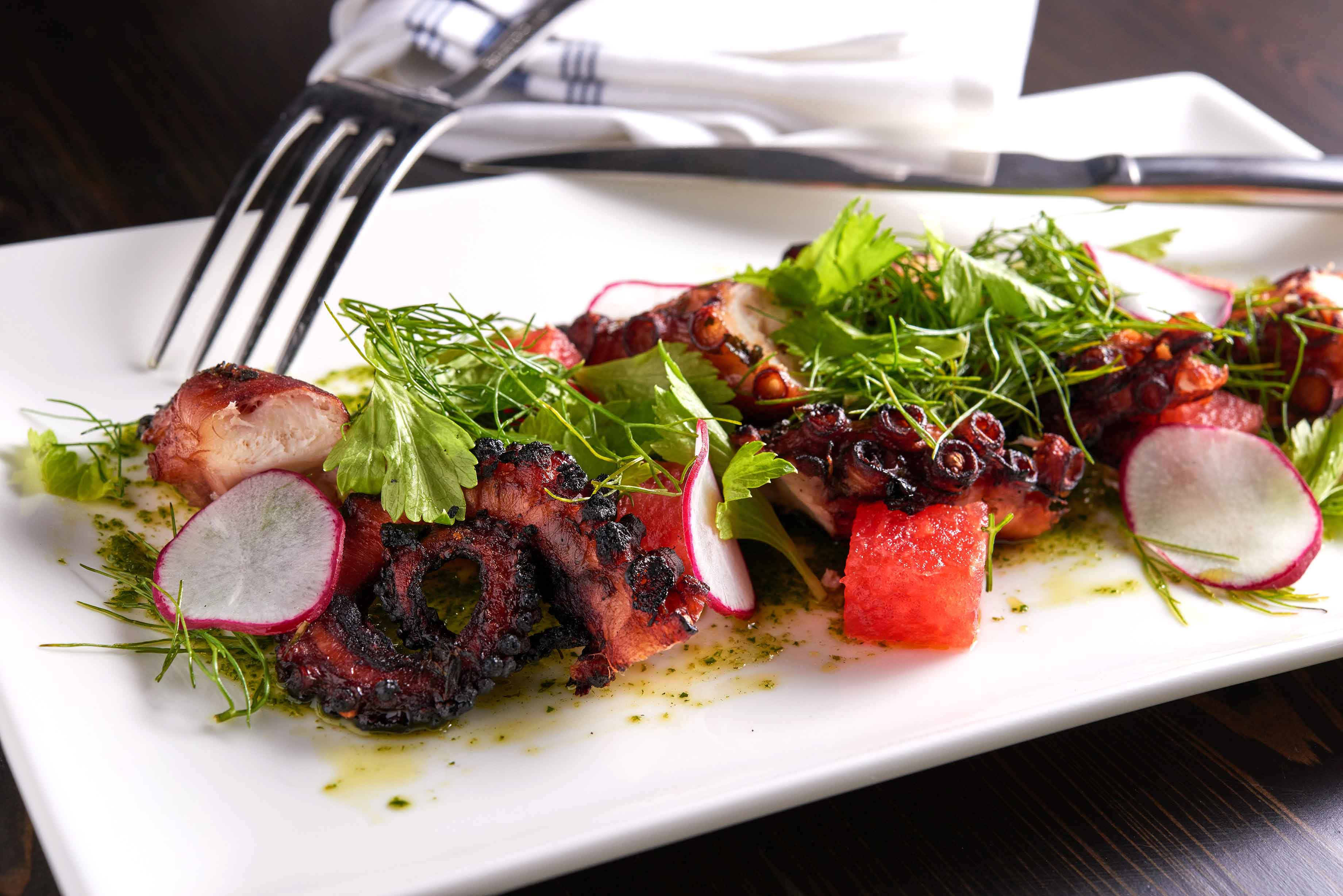 Avo’s very tender
charred octopus has cool watermelon, mango and
radish in tandem with an assertive Calabrian chili
glaze ($10), and, although rather salty when I
dined there, the ricotta and porcini gnudi
pasta are light and nicely sauced with a fontina
fonduta ($12).
Classic lasagna alla Bolognese with a
béchamel sauce and short rib ragù ($21) was as
hearty as it was deeply flavorful, and although
the rice in the lobster risotto with peas ($19)
was a bit overcooked, it was a good dish. Bucatini alla
carbonara ($15) veers from traditional
preparations by placing a poached egg on top to be
mixed with the pancetta
and pecorino ($15).
Avo’s very tender
charred octopus has cool watermelon, mango and
radish in tandem with an assertive Calabrian chili
glaze ($10), and, although rather salty when I
dined there, the ricotta and porcini gnudi
pasta are light and nicely sauced with a fontina
fonduta ($12).
Classic lasagna alla Bolognese with a
béchamel sauce and short rib ragù ($21) was as
hearty as it was deeply flavorful, and although
the rice in the lobster risotto with peas ($19)
was a bit overcooked, it was a good dish. Bucatini alla
carbonara ($15) veers from traditional
preparations by placing a poached egg on top to be
mixed with the pancetta
and pecorino ($15).
Main portions are gargantuan in
size: A massive, succulent lamb chop with Parisian
gnocchi, onion puree, radicchio, olives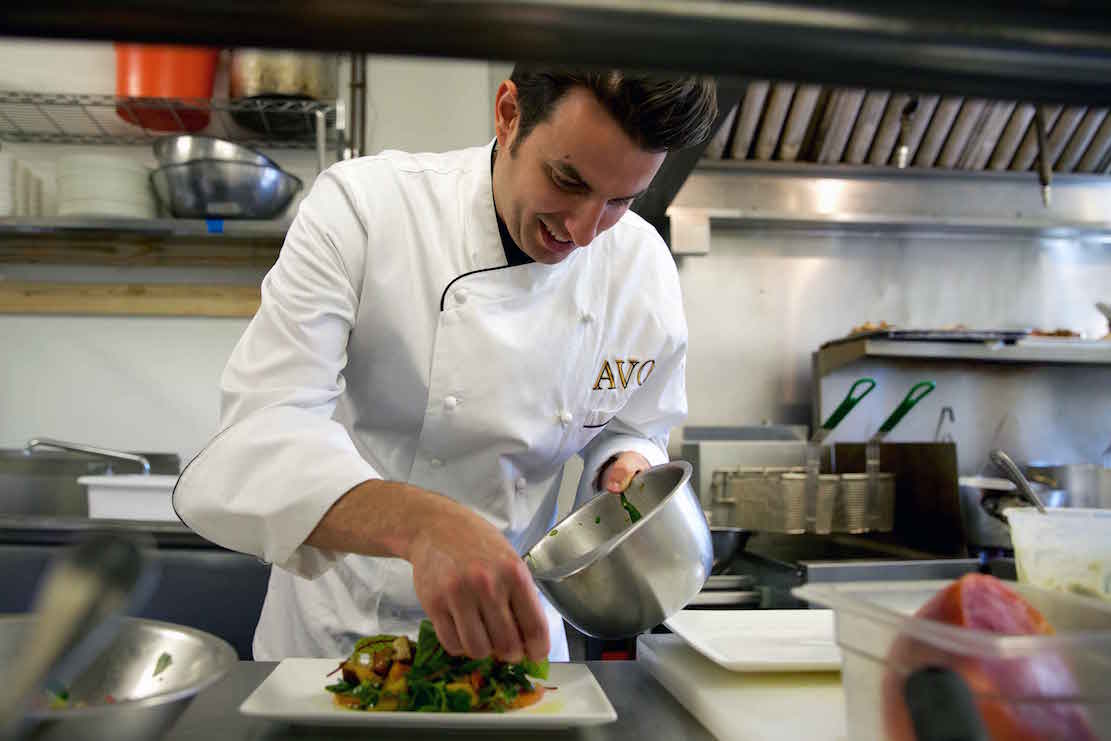 and balsamic ($33) absorbed all the
flavors on the plate, while a New York strip steak
($32) took well to a lush covering of Gorgonzola,
with tomatoes, grilled lemon, arugula and Yukon
gold potatoes.
Despite unexpected complexity, there’s
no disputing the enjoyment of veal milanese
adorned with cherries, fregula, mint, olives,
arugula and charred onions ($31). But my
favorite dish of the evening was shrimp and pork
cheek, deftly married with eggplant, garlic-raisin
agrodolce,
pine nuts and mint ($27). Lama
wants you to love his generosity with ingredients,
but Italian food by its nature should be simpler
and concentrate on two or three; I suspect he will
evolve in this regard.
and balsamic ($33) absorbed all the
flavors on the plate, while a New York strip steak
($32) took well to a lush covering of Gorgonzola,
with tomatoes, grilled lemon, arugula and Yukon
gold potatoes.
Despite unexpected complexity, there’s
no disputing the enjoyment of veal milanese
adorned with cherries, fregula, mint, olives,
arugula and charred onions ($31). But my
favorite dish of the evening was shrimp and pork
cheek, deftly married with eggplant, garlic-raisin
agrodolce,
pine nuts and mint ($27). Lama
wants you to love his generosity with ingredients,
but Italian food by its nature should be simpler
and concentrate on two or three; I suspect he will
evolve in this regard.
As dessert, s’mores
seemed a little out of character but they were
good. Avo’s
cocktails run $10-$12, and the wine list is very
well chosen and very fairly priced, with a
judicious number of bottles under $50.
(By the way, since Avo is a
ways from downtown,
I found using Uber much cheaper than New
Orleans taxis for distances like this.)
Open Mon.-Sat.
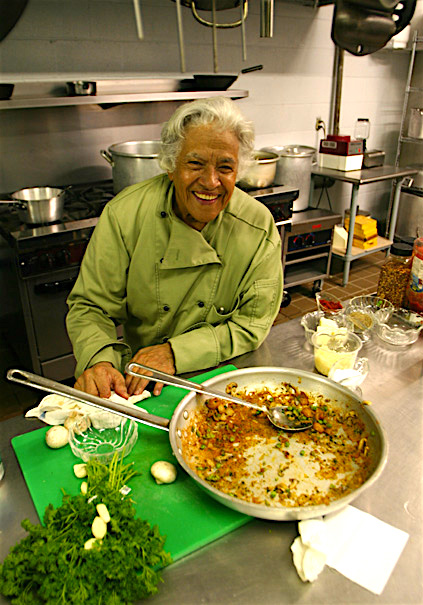 DOOKY
CHASE
DOOKY
CHASE
2301 Orleans Avenue
504-821-0600
In
no uncertain terms, Leah Chase, now 93, is a
patron saint of New Orleans cuisine, one of 14 children,
who in 1945 married musician Edgar
"Dooky" Chase II, whose parents owned a sandwich
shop, Dooky Chase, that evolved and eventually
expanded to take over the entire block. During
the 1960s black and white civil rights activists
met at the restaurant at a time when New Orleans
was still highly segregated. She was also an early
patron of African-American artists and serves on
the Board of the New Orleans Museum of Fine Arts.
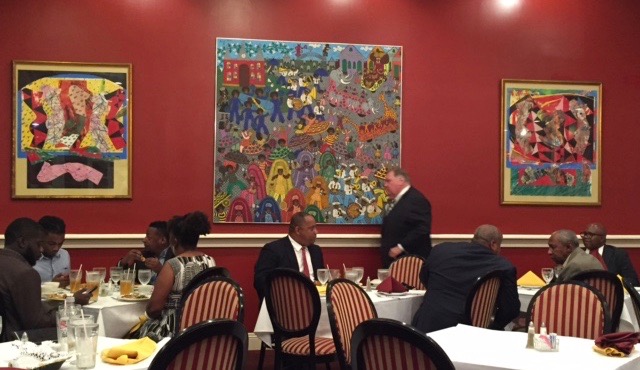
Known for wearing a red
kerchief, which some said made her look like the
cereal box Aunt Jemima figure they felt was
racist, Chase would reply: “She had her face on
every cereal box in the country. She had
that fat, round face, so beautiful and happy. I’d
like to have my picture
on
all those cereal boxes. [Women like] Aunt Jemima
were good, clean, working people [with] nothing to
be ashamed of.”
In 2005 Hurricane Katrina shut
down her restaurant, but the city’s restaurant
community vowed to help Chase re-open two years
later by holding a benefit that raised $40,000. So I
was deliriously happy to return to Dooky Chase and
to find Leah still in the kitchen, as welcoming as
the day I met her forty years ago.
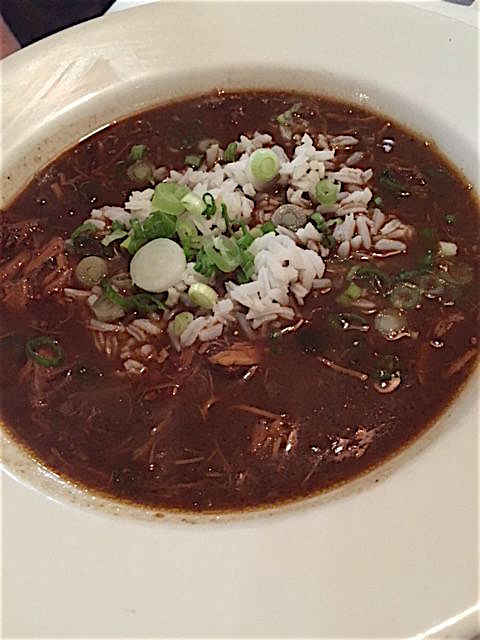 The
place was packed as usual with a mix of white and
black residents, slickly dressed local pols and
ministers, and tourists who came for New Orleans
Southern cooking perfected long before the words
“soul food” were coined. The buffet lunch is lavish
with Creole gumbo (left), red beans and lima beans
(oddly different from the usual red beans), po’
boy sandwiches, shrimp Clemençeau, and superb
fried chicken. For dessert there's peach cobbler
and one of the city's best read puddings.
The
place was packed as usual with a mix of white and
black residents, slickly dressed local pols and
ministers, and tourists who came for New Orleans
Southern cooking perfected long before the words
“soul food” were coined. The buffet lunch is lavish
with Creole gumbo (left), red beans and lima beans
(oddly different from the usual red beans), po’
boy sandwiches, shrimp Clemençeau, and superb
fried chicken. For dessert there's peach cobbler
and one of the city's best read puddings.
The waitstaff couldn’t be more
cordial, ever smiling, clearly as happy to be
working at Dooky Chase’s as they are to be a part
of Leah Chase’s great legacy to her beloved city. Feisty,
glowing with energy to spare, she is a unique
presence and a giant of American cuisine.
Open for lunch Tues.-Fri.; dinner Fri.; prices
at dinner are $7.95-$12.95 for appetizers,
$19.95-$24.95 for entrees.
❖❖❖
By John Mariani

New Canaan, CT
203-966-4000
The
much-hyped phrase “farm to table” has become
so empty of meaning that when you come upon
the real thing, you can still be amazed at the
idea. For
while all food has to come from some farm or
body of water, most restaurants only pay lip
service to the commitment to obtain the finest
provender from the most local purveyors.
Sandy and Angela Baldanza (below) have
not wavered in that search, a path that began,
ironically, in the fashion industry, where the
couple met (he had his own label, she worked at
Bloomingdale’s).
They left all that behind to open
Baldanza for breakfast, lunch and dinner to a
very faithful and appreciative clientele who are
assured that everything on the changing menu is
as fresh, organic and well-sourced as possible,
always at a very fair price. Indeed,
their Americana Menu, served Wednesday and
Thursday is fixed price at $28 for three
courses. Of course, they do take-out, too, and
New Canaanites in their Range Rovers pull up to
the curb to collect their evening meal.
Baldanza’s has even launched a range of soups
they call Soup Kitchen for sale at Walter
Stewart’s Market, with two percent of sales
going to the Connecticut Food Bank.
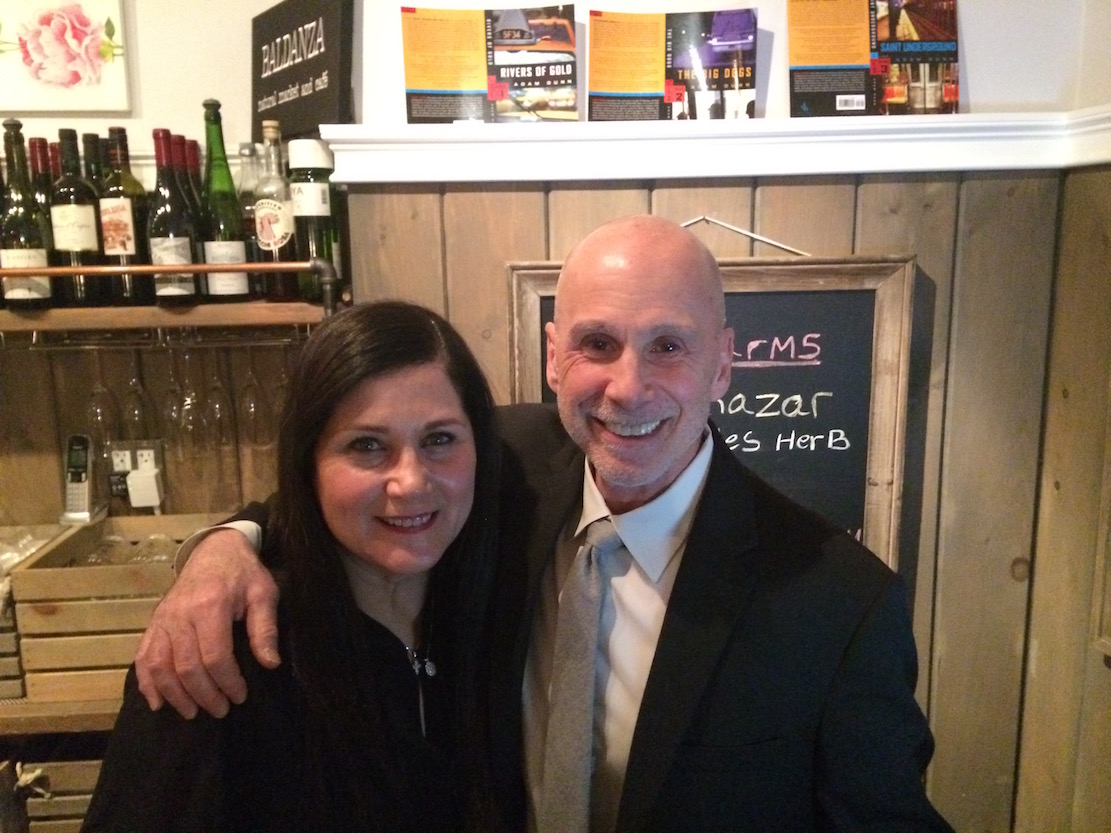 The restaurant is
small, L-shaped, with a bar behind which the
Baldanza’s son Alex works as bartender. It’s
a comfortable, if slightly cramped, spot but it
can get very loud when it fills up at night, and
midday seems to be a prime time for ladies to
lunch.
The restaurant is
small, L-shaped, with a bar behind which the
Baldanza’s son Alex works as bartender. It’s
a comfortable, if slightly cramped, spot but it
can get very loud when it fills up at night, and
midday seems to be a prime time for ladies to
lunch.
It is highly likely Sandy
will be coming to your table throughout the
night to check on every detail, and be aware
that asking him a question about his culinary
philosophy may elicit a very, very long answer.
His passion for what he does is more than
palpable.
The à la carte menu is
ambitious for such a small kitchen, but almost
everything I tasted along with three friends
showed remarkable consistency of taste and
preparation.
Hand-cut tuna with Himalayan salt, skinny
French fries, lamb’s lettuce and cilantro ($18)
is similar to other versions around the area, 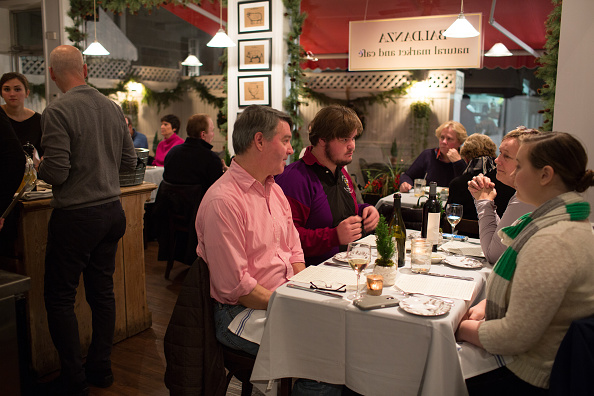 but Baldanza’s tuna
has deep flavor, and cutting it to order makes a
huge difference, while the lamb’s lettuce and
cilantro add additional savory notes.
but Baldanza’s tuna
has deep flavor, and cutting it to order makes a
huge difference, while the lamb’s lettuce and
cilantro add additional savory notes.
Buffalo mozzarella—so often a
hit or miss item—is here impeccably creamy with
the right pliant texture, served with organic
tomatoes, a strawberry balsamic,
and—surprise!—New Canaan olive oil ($15). A
light lentil soup was absolutely delicious, full
of vegetable flavors ($8). Crispy
fried calamari with lemon garlic aïoli and
roasted tomato sauce ($16) was not
so special.
There are several pastas—the
Baldanzas are Italian-Americans—including very
good butternut squash-stuffed ravioli glossed
with sage and brown butter ($24) and ricotta
gnocchi, slightly too firm, with a rich sauce of
tomato fillets ($24). Freshly made pappardelle
comes in a fine meat sauce with freshly made
ricotta ($24), while fragrant saffron risotto is
melded with Gulf shrimp and asparagus, both a
tad overcooked that evening, rendering the
shrimp without flavor ($28).
Everything the Baldanzas make
evokes the idea of comfort food, and what could
be more comforting than crispy Parmesan-crusted
organic chicken with kale, wild mushrooms and
mashed sweet potato ($27), one of the best
dishes on the menu? The same goes for a juicy
double-cut pork chop, grilled and served with
pan-roasted asparagus and wonderful mashed
potatoes ($36).
Whatever local fish is the
best in that day’s market gets a treatment of
parmesan crust similar to the chicken, with
sautéed spinach and lovely, silky beurre blanc
($28), while a snowy white Maine halibut with
risotto, wild arugula and a citrus wine sauce
($32) takes a delicate hand to render so
flawlessly.
Sandy Baldanza raved about
his wife’s carrot cake for good reason. This old
classic, lost in culinary hippie history after
overkill in 1970s, shows what a wonderful
American idea it is to combine carrots, spices
and cream cheese to such wonderful effect. The
crème brȗlée was all it should be—crackling
golden caramel crust and creamy, vanilla-rich
center. A bowl of autumn berries and cream was
as charming an idea for a simple dessert as
you’ll find. Key lime pie was all right, but not
a winner in its category.
This being a small place,
there’s no room for a huge wine list, but the
selection of whites, most under $40, is a good
one, though the red wine list could use
amplification. Nine wines are offered by
the glass, all at a very reasonable $10. There
are also a dozen craft beers.
❖❖❖

Star Lane Vineyard
DIERBERG WINERY WANTS TO PUT
SANTA BARBARA AVA IN THE BIG
LEAGUES
By John Mariani
It’s
not everyday a vineyard owner tells you where to
find the keys to the estate and the house where
you’ll be living.
But when Tyler Thomas and his wife
arrived at the Dierberg and Star Lane Winery in
Santa Barbara County in the summer of 2013, that
was his introduction to his life as the estate’s
new winemaker.
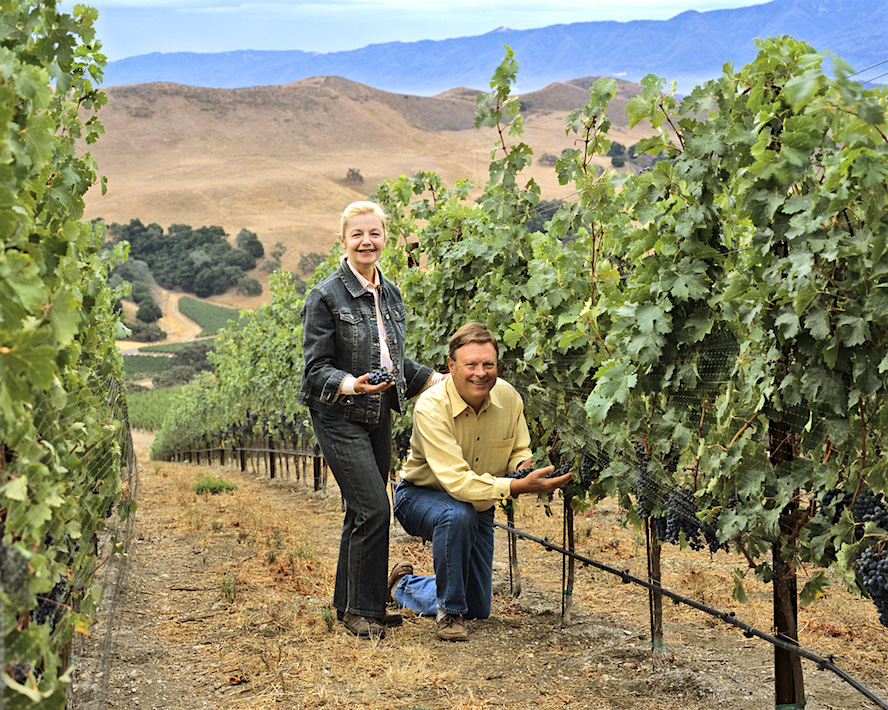 The winery
had been founded in 1996 by bankers Jim and Mary
Dierberg (left)
of Hermann, Missouri, where they have for
forty-two years owned the Hermannhof Winery and
brought it to prominence as one of the best in the
Midwest. But
the region didn’t support traditional European
varietals of a kind the Dierbergs favored, so,
after exhaustive—and, one can imagine, quite
pleasurable—searches throughout France and Napa
Valley, they finally settled on the cool climate
of Santa Barbara County, where they now produce
wines under the Dierberg, Star Lane and Drum
Vineyard labels.
Now, with Jim, 79, retired as Chairman of
the Board of First Banks Inc. (his son Michael is
still on the board) and having more time to devote
to his wine passion, he intends to make the finest
wines in a region that often plays second fiddle
to Napa and Sonoma.
The winery
had been founded in 1996 by bankers Jim and Mary
Dierberg (left)
of Hermann, Missouri, where they have for
forty-two years owned the Hermannhof Winery and
brought it to prominence as one of the best in the
Midwest. But
the region didn’t support traditional European
varietals of a kind the Dierbergs favored, so,
after exhaustive—and, one can imagine, quite
pleasurable—searches throughout France and Napa
Valley, they finally settled on the cool climate
of Santa Barbara County, where they now produce
wines under the Dierberg, Star Lane and Drum
Vineyard labels.
Now, with Jim, 79, retired as Chairman of
the Board of First Banks Inc. (his son Michael is
still on the board) and having more time to devote
to his wine passion, he intends to make the finest
wines in a region that often plays second fiddle
to Napa and Sonoma.
“The family was happy with the
wines they were making,” says Thomas,
who had worked in the Central Coast in the past
but spent most of his career in Sonoma, “but they
recognized they had not yet reached their
potential. They knew what they had and what they
had accomplished and they told me, `We don’t care
if you’re Einstein.
If you come in and disrupt the culture, we
don’t want you.’”
When the stars
aligned, the Dierbergs and Thomas (below) came
together with a common goal: “The entire valley
made its imprint on me as I sampled vineyards in
Santa Maria Valley, Happy Canyon and Santa
Rita Hills. To be returning after 10 years
to make site-driven estate wines is thrilling.”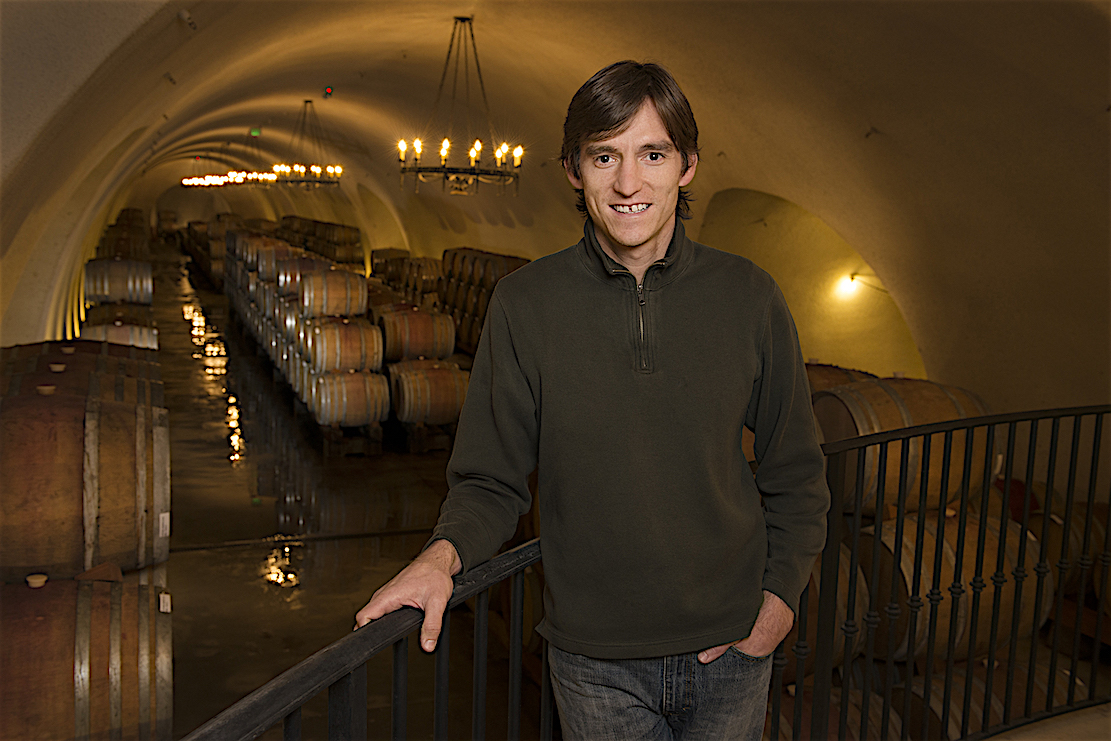
Thomas, 39,
himself born in Missouri, looks like a young Hoagy
Carmichael and has some of the same ironic wit.
Taking on the job at Dierberg was daunting but he
had never turned down a challenge: he and his wife
always took the road less traveled, to New Zealand
and Europe, often with next-to-no money in their
pockets. But eventually Thomas fell in thrall to
the world of
viticulture, completed his B.S. and M.S.
degrees in Botany at Colorado State University,
and received a masters in Viticulture and Enology
at U.C. Davis. He
took a full-time harvest internship at Fiddlehead
Cellars in Santa Barbara, where he had his first
taste working with Happy Canyon fruit.
He
then joined Hyde de Villaine (HdV) winery,
learning Burgundian-style winemaking there with
Stéphane Vivier, who showed him how to focus on
what’s most important and to discard all that is
not.
He took a full-time harvest internship at
Fiddlehead Cellars in Santa Barbara, where he had
his first taste working with Happy Valley
fruit. With grant money from U.C. Davis
Tyler d research in Germany, then returned to HdV, then
worked as winemaker at Donelan Family Wines before
returning to Santa Barbara to work at Dierberg and
Star Lane Vineyards.
“My friends in Sonoma told me
that if you want to make movies, you don’t leave
Hollywood, but I liked the challenge of going to
the Central Coast. My goal—and that of the
Dierbergs—is to make wines that please by their
compelling nature. That is, you find
yourself both hedonistically and intellectually
compelled to go back to the wine over and over
again. Many wines can draw your first
glance, but I want one that can sustain your
desire.”
While in synch with the Dierbergs' ideas
that their wines should taste
distinctly
theirs, Thomas insists a winemaker should always
“fear the house palate,” meaning that forcing a
vintage always to adhere to a set style is
wrong-headed.
“We need to find what the wine will taste
like from the grapes of an individual lot, and if
it does not meet my expectations, I’ll sell it to
someone else.
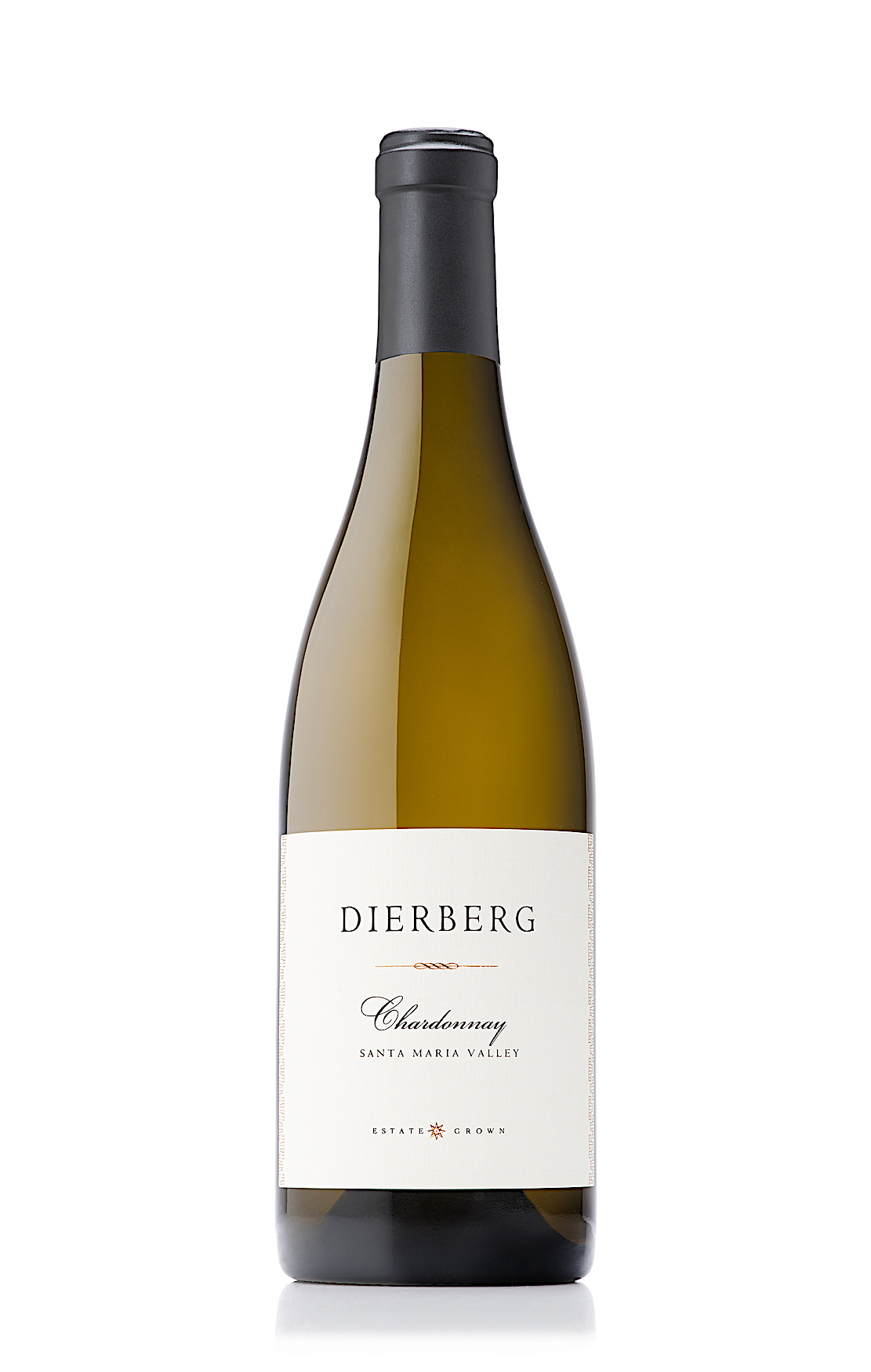 “There is an
architecture to wines—bones, scaffolding,
structure—so you have to be careful not to
manipulate it back at the wine or it crumbles. I
look for balance, length, and, because Santa
Barbara can be 15 degrees lower than in Napa or
Sonoma, the fruit ripens in its own way and time.
Great wines start in the vineyard, not in the
winery.”
“There is an
architecture to wines—bones, scaffolding,
structure—so you have to be careful not to
manipulate it back at the wine or it crumbles. I
look for balance, length, and, because Santa
Barbara can be 15 degrees lower than in Napa or
Sonoma, the fruit ripens in its own way and time.
Great wines start in the vineyard, not in the
winery.”
Over dinner in New York at Ai
Fiori restaurant, Thomas and I spoke about his
methods and philosophy, and of course we tasted
some of Dierberg’s current releases, which went
very well indeed with shavings of fresh white
truffles over risotto, and vice-versa. The
2013s were the first he oversaw in the vineyards.
The 2013 Dierberg Santa Maria Valley
Chardonnay, Dierberg Vineyard ($32) is a big
chard, spending 16 months aging, 12 in new French
oak, and its 14.6 percent alcohol is more than a
tipping point for me, by which the wine tastes too
ripe, with too much oak. A bit of subtlety is to be
preferred, even though Chardonnay is a grape that
for some winemakers is a tabula rasa.
The 2013 Dierberg Santa Rita
Hills Pinot Noir, Drum Canyon Vineyard ($52) comes
from an early ripening vintage, and its lovely
spice came from “stem inclusion” and it structure
from 15 months 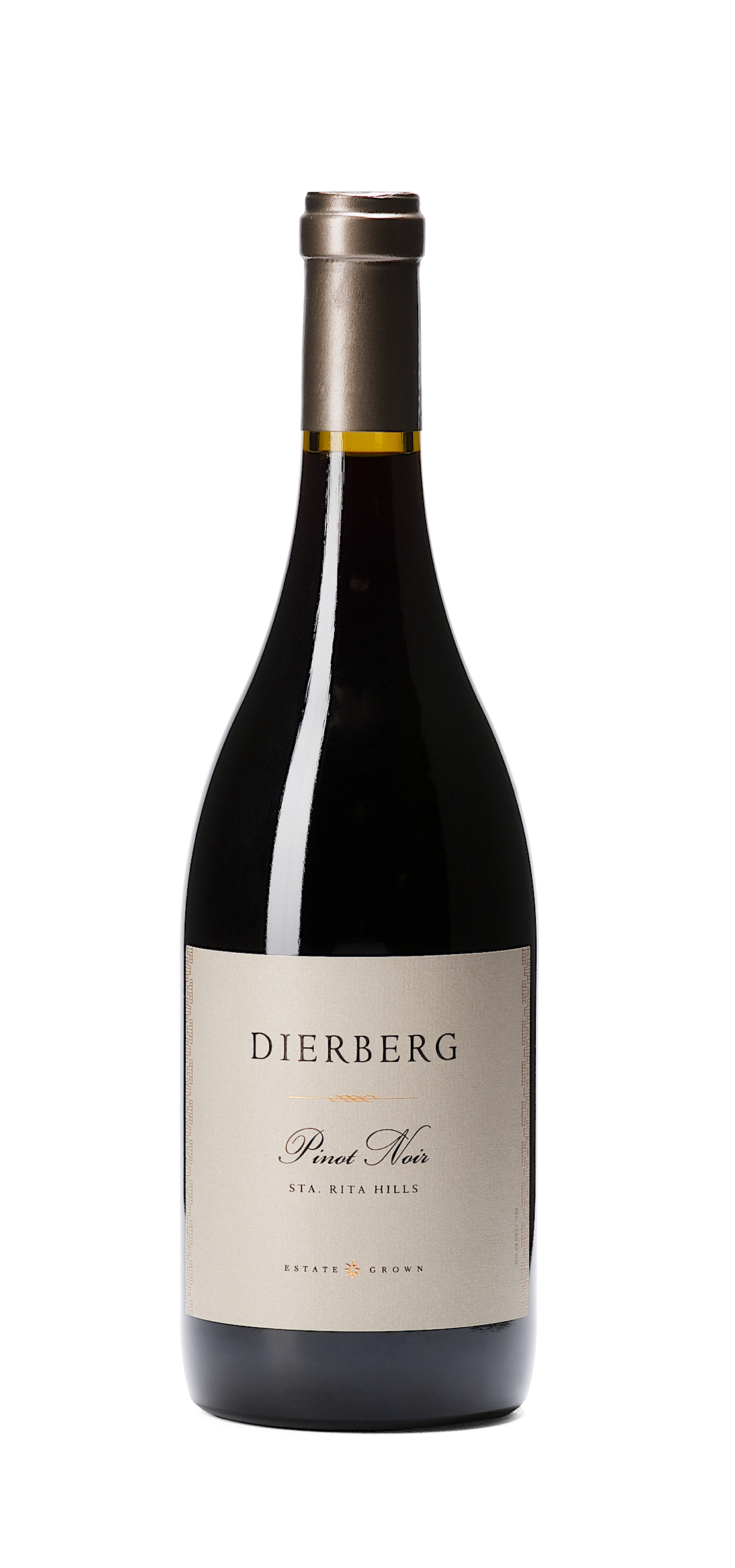 in new
French oak.
But here the 14.1 percent alcohol is a
virtue, keeping the freshness of the Pinot Noir
fruit foremost, with no cloying aftertaste. This is
a good price for a wine of this caliber.
in new
French oak.
But here the 14.1 percent alcohol is a
virtue, keeping the freshness of the Pinot Noir
fruit foremost, with no cloying aftertaste. This is
a good price for a wine of this caliber.
The 2014 vintage of the same
wine ($52) is a lighter Pinot Noir but in some
ways closer to fine Burgundy, as is its 13.2
percent alcohol,
so that there is still a fullness that is
somewhat more refined and bodes well for aging in
the bottle, while still a lovely wine of the
moment, perfect with those white truffles.
Dierberg’s
Star Lane vineyard makes Cabernet Sauvignons that
tend not to be as muscular as those from Napa
Valley, and the 2013 Star Lane Vineyard Cabernet
Sauvignon, Happy Canyon of Santa Barbara ($50) is
something of an experiment in that 30 different
Cabernet lots were assessed before actual
production.
Thomas says of the wine, which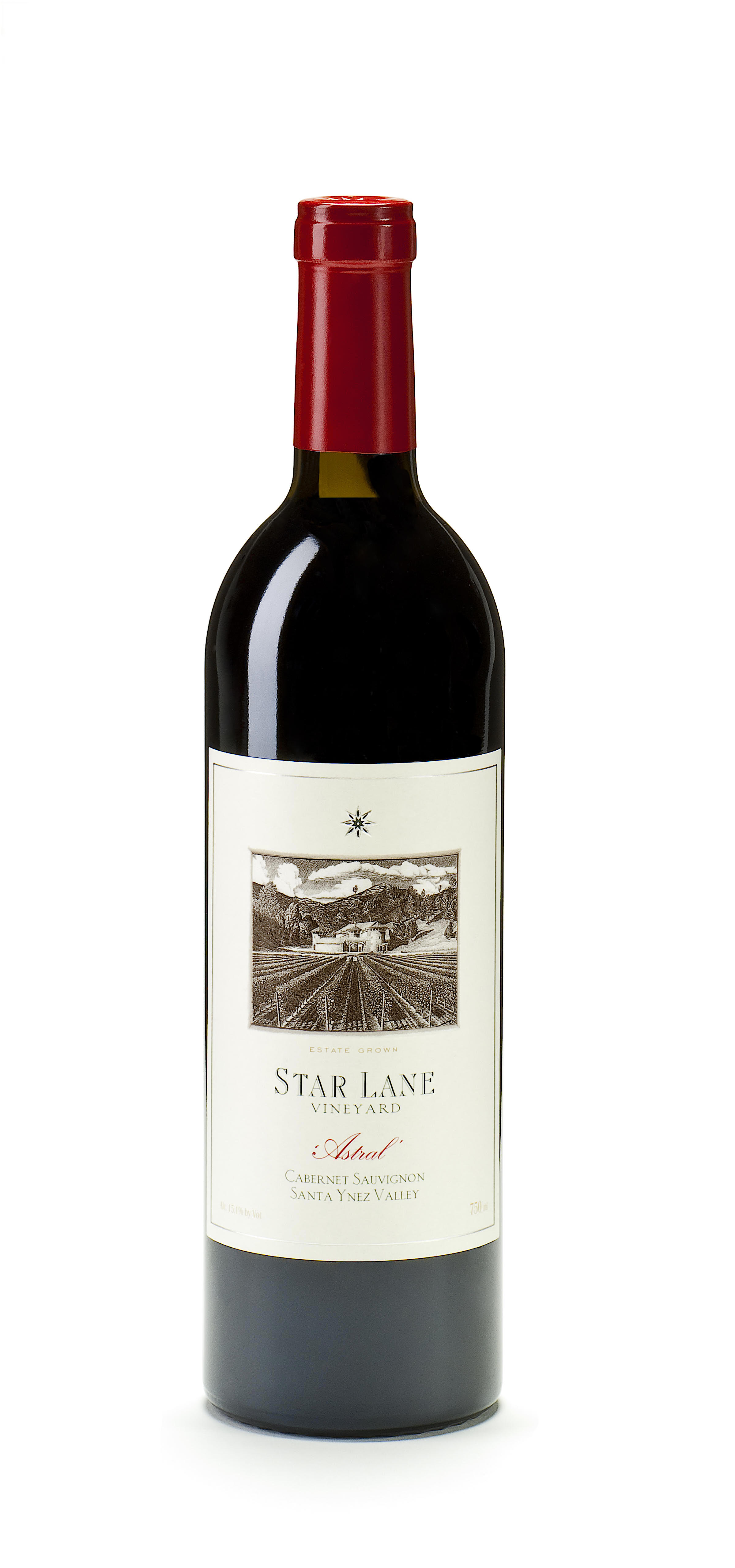 has 84% Cab, 10% Cabernet Franc, 4%
Merlot and 2% Malbec and spends 20 months aging,
“There is certainly a `mark’ to Star Lane [but]
describing it is no easy task. This
youthful expression of Cabernet currently shows a
floral, sage-like quality that seems to mask
darker fruits we observed in the cellar prior to
bottling.” At
14.4% alcohol it has excellent balance of fruit,
acid and developing tannins. It went impeccably
with a two-inch thick veal chop.
has 84% Cab, 10% Cabernet Franc, 4%
Merlot and 2% Malbec and spends 20 months aging,
“There is certainly a `mark’ to Star Lane [but]
describing it is no easy task. This
youthful expression of Cabernet currently shows a
floral, sage-like quality that seems to mask
darker fruits we observed in the cellar prior to
bottling.” At
14.4% alcohol it has excellent balance of fruit,
acid and developing tannins. It went impeccably
with a two-inch thick veal chop.
At a time when most California Cabernet
producers now blend in other varietals, as in
Bordeaux, the 2013 Star Lane Vineyard “Astral,”
Happy Canyon of Santa Barbara ($120) is the
winery’s entry into the higher stakes of 100%
Cabernet Sauvignons, with fruit pulled from a plot
at the highest altitude (1,500 feet above sea
level), which is sunny but cooler. The floral
qualities are now in bloom, emerging from the
density of the wine. The sensible 14.5% alcohol
will help improve the balance rather than dry the
wine out, and it’s going to take a few years to
come to its full maturity.

RUDY GIULIANI ALSO VOLUNTEERED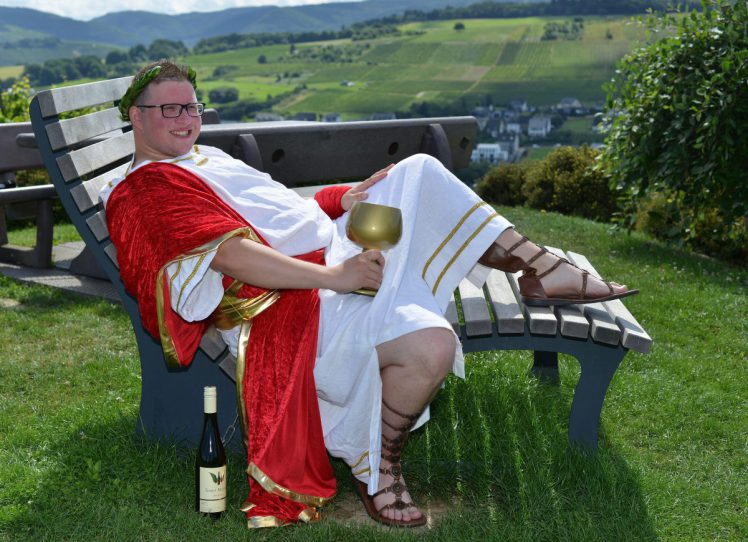
The village of
Kesten in southern Germany just elected its first male
"wine queen" after it failed to find any women willing
to do the job. According to NBC News, Kesten, with 25
wineries, has long relied on “wine queens,” to act as
brand ambassadors for the wines produced in their
villages, so 24-year-old law student named Sven Finke (right) said he’d be
the wine queen, and the town took him seriously.
Wine queens traditionally wear dirndls and tiaras, but
Kesten has decided to wear a gold laurel wreath
and a toga while carrying out his wine queen duties.
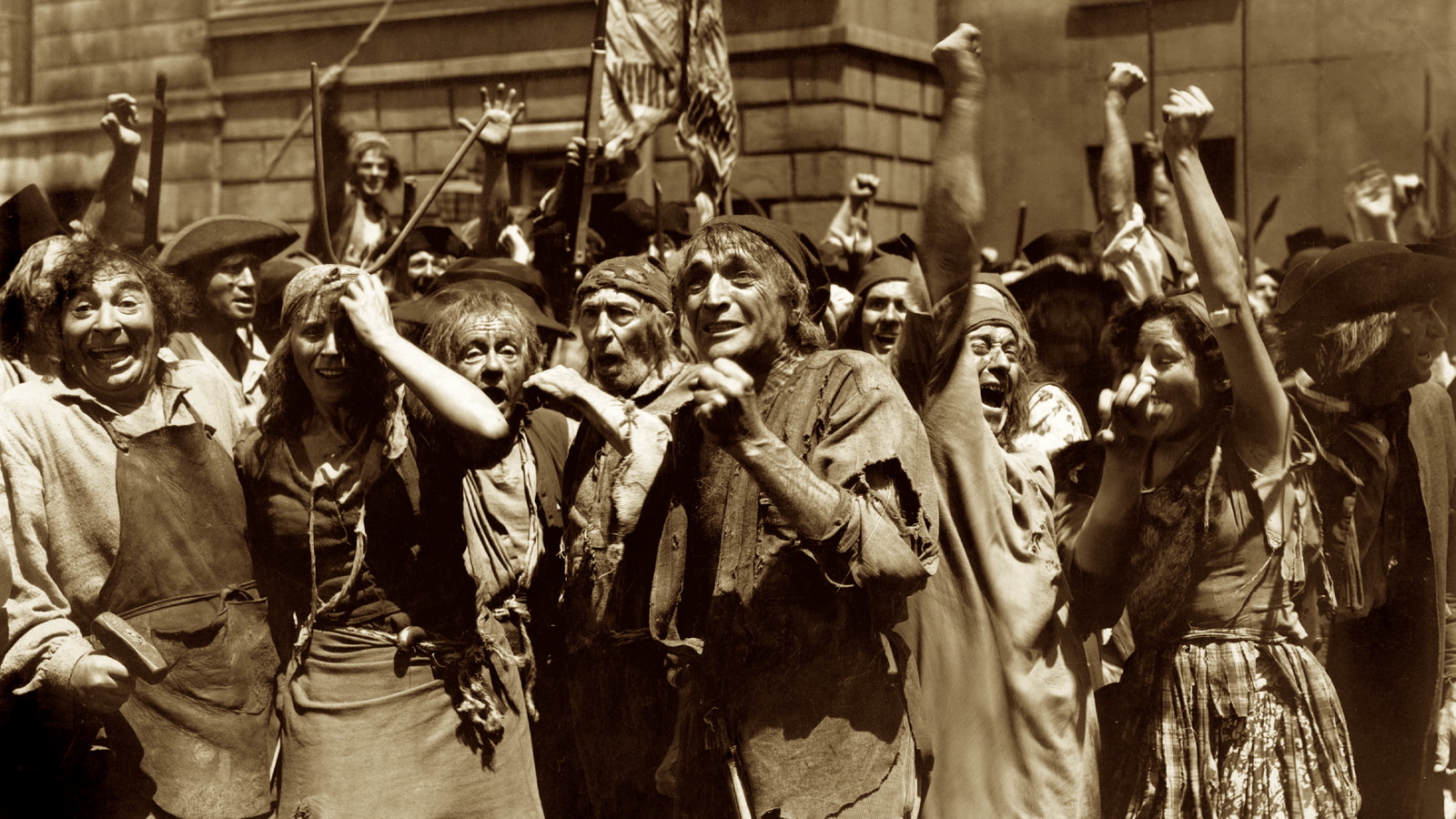
BLOCK THAT METAPHOR!
“Much
of the cooking revolves around glossy, spoon-coating,
cream- and butter-reinforced sauces that some younger
diners have never tasted. These sauces aren’t remotely
heavy or deadening, two of the charges hurled at them
when they were led to the guillotines by the
Robespierres of nouvelle cuisine.”—Pete Wells, “Le Cou
Cou,” NY Times
(11/1/16)
❖❖❖
Sponsored by Banfi Vintners
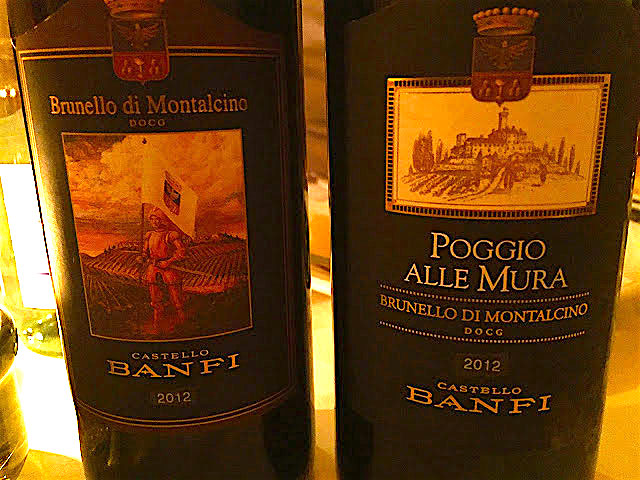 Exclusive First
Look at Brunello 2012
Exclusive First
Look at Brunello 2012
By John
Fodera, Tuscan
Vines
Yes, I said 2012 and it's not a
typo. I
am pleased to provide this exclusive early look at
what is likely to be a rather excellent vintage for
Brunello di Montalcino.
The wines below are finished blended wines, not
barrel samples, and are waiting patiently for January
2017 when they will be officially presented at
Benvenuto Brunello.
These bottles were provided to me directly from
the Castello Banfi cellar in Montalcino and had
pristine provenance.
When I attended Benvenuto Brunello
as the 2009s were released, what accompanied them were
the delicate and delicious 2012 Rosso di Montalcino.
At that time, I began anticipating what the 2012
Brunello would become.
This, albeit miniscule sampling, provides a bit
of insight.
Recently, at an intimate trattoria in Manhattan, we
sampled the following wines with Enrico Viglierchio,
the General Manager of the Castello Banfi Estate, who
will be the subject of a future interview.
2012 Castello Banfi Estate Brunello: The first word in my tasting notebook is "Wow!" This is a deep, dark cherry red that is nearly opaque clear to the rim of the glass. The aromas from the wine are very expressive with fresh flowers, baking spices and vibrant fresh tobacco leaf notes. There's tons of red fruit here and amazing freshness. Soft vanilla notes appear on the finish where this stays ripe and lively. 95 points
2012 Castello Banfi
Poggio Alle Mura Brunello: Ever so
slightly darker than the estate Brunello, this wine
exhibits wonderful aromas of crushed cherry and soft
vanilla notes. It's
restrained somewhat on the nose. On the
palate, the wine is much more exuberant and is
absolutely loaded with spicy, ripe cherry fruit, fresh
herb/anise notes and hints of vanilla. Long, long
finish that trails off delicately with more black
pepper on the end.
Definitely built for aging. 95+ points.
It was very interesting to check in on these wines and
I'll be curious to taste them again in January. While it's
not surprising that these wines exhibited very vibrant
fruit profiles and a bit more pronounced attributes
from oak, I
do expect that they will soften and integrate a bit
before their official debut in January and further
still by the time they arrive on the market. Although
this was a small sample size, they displayed
everything I remember from tasting the 2012 Rossos and
then some, which is exactly what you'd expect. Despite not
decanting any of the wines, they were very forward and
not shy with their character, even if they were mostly
driven by primary fruit. What's more, they were
accessible, without loads of tannins obscuring their
balance, finesse or elegance.
All were served with a variety of
appropriate foods including various pastas, cheeses,
chicken, porterhouse steak and even fish! They were
elegant and fresh with and without the food, though on
their own, you could sense the structure from the
tannins much more noticeably.
Visit
http://TuscanVine.com for more coverage!
Salute!
❖❖❖
Any of John Mariani's books below may be ordered from amazon.com.
 The
Hound in Heaven (21st Century Lion Books)
is a novella, and for anyone who loves dogs,
Christmas, romance, inspiration, even the supernatural, I
hope you'll find this to be a treasured favorite.
The story concerns how, after a New England teacher,
his wife and their two daughters adopt a stray puppy found
in their barn in northern Maine, their lives seem full of
promise. But when tragedy strikes, their wonderful dog
Lazarus and the spirit of Christmas are the only things
that may bring his master back from the edge of
despair.
The
Hound in Heaven (21st Century Lion Books)
is a novella, and for anyone who loves dogs,
Christmas, romance, inspiration, even the supernatural, I
hope you'll find this to be a treasured favorite.
The story concerns how, after a New England teacher,
his wife and their two daughters adopt a stray puppy found
in their barn in northern Maine, their lives seem full of
promise. But when tragedy strikes, their wonderful dog
Lazarus and the spirit of Christmas are the only things
that may bring his master back from the edge of
despair. WATCH THE VIDEO!
“What a huge surprise turn this story took! I was completely stunned! I truly enjoyed this book and its message.” – Actress Ali MacGraw
“He had me at Page One. The amount of heart, human insight, soul searching, and deft literary strength that John Mariani pours into this airtight novella is vertigo-inducing. Perhaps ‘wow’ would be the best comment.” – James Dalessandro, author of Bohemian Heart and 1906.
“John Mariani’s Hound in Heaven starts with a well-painted portrayal of an American family, along with the requisite dog. A surprise event flips the action of the novel and captures us for a voyage leading to a hopeful and heart-warming message. A page turning, one sitting read, it’s the perfect antidote for the winter and promotion of holiday celebration.” – Ann Pearlman, author of The Christmas Cookie Club and A Gift for my Sister.
“John Mariani’s concise, achingly beautiful novella pulls a literary rabbit out of a hat – a mash-up of the cosmic and the intimate, the tragic and the heart-warming – a Christmas tale for all ages, and all faiths. Read it to your children, read it to yourself… but read it. Early and often. Highly recommended.” – Jay Bonansinga, New York Times bestselling author of Pinkerton’s War, The Sinking of The Eastland, and The Walking Dead: The Road To Woodbury.
“Amazing things happen when you open your heart to an animal. The Hound in Heaven delivers a powerful story of healing that is forged in the spiritual relationship between a man and his best friend. The book brings a message of hope that can enrich our images of family, love, and loss.” – Dr. Barbara Royal, author of The Royal Treatment.
 |
The Encyclopedia of American Food and Drink by John F. Mariani (Bloomsbury USA, $35) Modesty forbids me to praise my own new book, but let me proudly say that it is an extensive revision of the 4th edition that appeared more than a decade ago, before locavores, molecular cuisine, modernist cuisine, the Food Network and so much more, now included. Word origins have been completely updated, as have per capita consumption and production stats. Most important, for the first time since publication in the 1980s, the book includes more than 100 biographies of Americans who have changed the way we cook, eat and drink -- from Fannie Farmer and Julia Child to Robert Mondavi and Thomas Keller. "This book is amazing! It has entries for everything from `abalone' to `zwieback,' plus more than 500 recipes for classic American dishes and drinks."--Devra First, The Boston Globe. "Much needed in any kitchen library."--Bon Appetit. |
"Eating Italian will never be the same after reading John Mariani's entertaining and savory gastronomical history of the cuisine of Italy and how it won over appetites worldwide. . . . This book is such a tasteful narrative that it will literally make you hungry for Italian food and arouse your appetite for gastronomical history."--Don Oldenburg, USA Today. "Italian
restaurants--some good, some glitzy--far
outnumber their French rivals. Many of
these establishments are zestfully described
in How Italian Food Conquered the World, an
entertaining and fact-filled chronicle by
food-and-wine correspondent John F.
Mariani."--Aram Bakshian Jr., Wall Street
Journal.
"Equal parts
history, sociology, gastronomy, and just
plain fun, How Italian Food Conquered the
World tells the captivating and delicious
story of the (let's face it) everybody's
favorite cuisine with clarity, verve and
more than one surprise."--Colman Andrews,
editorial director of The Daily
Meal.com. "A fantastic and fascinating
read, covering everything from the influence
of Venice's spice trade to the impact of
Italian immigrants in America and the
evolution of alta cucina. This book will
serve as a terrific resource to anyone
interested in the real story of Italian
food."--Mary Ann Esposito, host of PBS-TV's
Ciao
Italia. "John Mariani has written the
definitive history of how Italians won their
way into our hearts, minds, and
stomachs. It's a story of pleasure over
pomp and taste over technique."--Danny Meyer,
owner of NYC restaurants Union Square
Cafe, The Modern, and Maialino.
|
 |
 |
 |
 |
 |
 |
 |
 |
 Everett Potter's Travel Report:
Everett Potter's Travel Report: 
 Eating Las Vegas
JOHN CURTAS has been covering the Las Vegas
food and restaurant scene since 1995. He is
the co-author of EATING LAS VEGAS – The 50
Essential Restaurants (the fourth
edition of which will be published in early
2016), as well as the author of the Eating Las
Vegas web site: www.eatinglasvegas.
He can also be seen every Friday morning as
the “resident foodie” for Wake Up With the
Wagners on KSNV TV (NBC) Channel 3 in
Las Vegas.
Eating Las Vegas
JOHN CURTAS has been covering the Las Vegas
food and restaurant scene since 1995. He is
the co-author of EATING LAS VEGAS – The 50
Essential Restaurants (the fourth
edition of which will be published in early
2016), as well as the author of the Eating Las
Vegas web site: www.eatinglasvegas.
He can also be seen every Friday morning as
the “resident foodie” for Wake Up With the
Wagners on KSNV TV (NBC) Channel 3 in
Las Vegas.

MARIANI'S VIRTUAL GOURMET
NEWSLETTER is published weekly. Editor/Publisher: John
Mariani.
Editor: Walter Bagley. Contributing Writers: Christopher Mariani,
Robert Mariani, Misha
Mariani,
John A. Curtas, Edward Brivio, Mort Hochstein,
Andrew Chalk, Dotty Griffith and Brian Freedman. Contributing
Photographers: Galina Dargery, Bobby
Pirillo. Technical Advisor: Gerry McLoughlin.
To un-subscribe from this newsletter,click here.
© copyright John Mariani 2016
